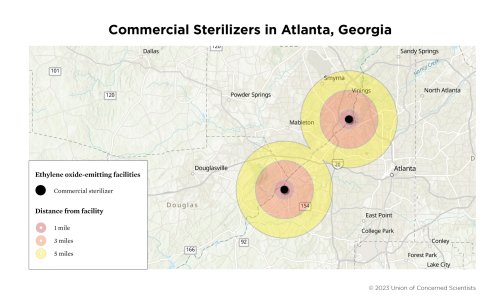Georgia has five commercial sterilizers. More than 412,000 Georgians (roughly 4 percent of the state population) live within five miles of at least one of these facilities (US Census Bureau 2020). Two facilities in Atlanta—Sterigenics and Sterilization Services of Georgia—are less than 10 miles apart.
The Sterilization Services facility has been subject to two formal enforcement actions by the EPA in the last five years for failing to comply with Clean Air Act requirements. The Sterigenics facility has been subject to one. The estimated air toxics cancer risk in the census tract with the Sterigenics facility is 100 additional cases per 1 million people; EtO emissions contribute to roughly three-quarters of the overall cancer risk in this tract (AirToxScreen 2022).
In 2020, the Sterilization Services facility was fined $3,000 a day for failing to adequately control EtO emissions (Buchanan 2020). Ninety-two percent of the roughly 96,000 people who live within five miles of the Sterilization Services facility identify as people of color (compared with the 58 percent county average). The proportion of people with low income is also greater than the county average. Grassroots groups like Stop Sterigenics Georgia have advocated for stronger emissions controls and accountability from these facilities (Stop Sterigenics—Georgia, n.d.).
Two additional sterilizers, in Covington and Madison, are just outside Atlanta. The estimated air toxics cancer risk in the census tract with Covington's Bard CR sterilizer is 300 additional cases per 1 million people. EtO emissions contribute to roughly 90 percent of the overall cancer risk in this census tract (AirToxScreen 2022).
